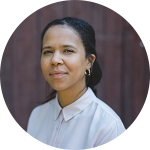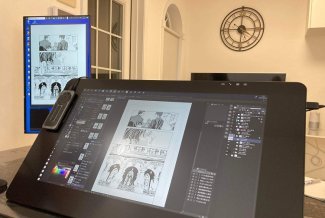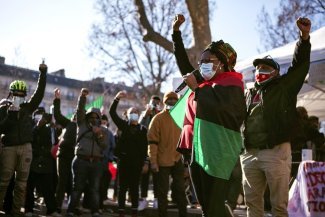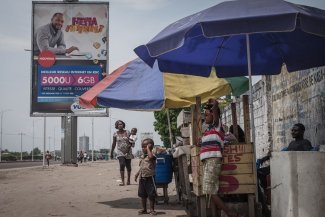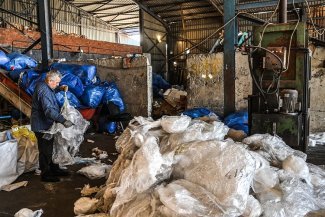Kandi Mossett of the Indigenous Environmental Network says “indigenous peoples only make up 4 per cent of the population, but our lands make up a majority of the resources of the fossil fuel industry”.
As a lead organiser with the Minnesota-based grassroots NGO Indigenous Environmental Network (IEN), Kandi Mossett’s work focuses on extreme energy and just transition. Mossett is also a member of the Mandan, Hidatsa and Arikara (MHA) Nation as well as a 37-year-old mother, who has been active in the Standing Rock protests since August last year. Demonstrators, including members of more than 200 indigenous nations across the United States, are trying to block the construction of the Dakota Access Pipeline in North Dakota. Since April 2016, protestors have set up vast camps at the Standing Rock Sioux Reservation to oppose the construction of a multi-billion dollar oil pipeline on grounds that it will contaminate water supplies and disturb sacred burial grounds. In an interview with Equal Times, which was conducted before President Trump signed a presidential memorandum advancing construction of the pipeline on 24 January, Mossett talks about the battle ahead now that Barack Obama is no longer in the White House.
Early in December 2016, the US Army announced that it would suspend work on the controversial Dakota Access Pipeline and that it would consider rerouting the project. Does that mean the fight is over?
No. The only power that the Army Corps of Engineers had was to deny the permit underneath the Missouri River. And as we’re all aware, Donald Trump is a supporter of the Dakota Access Pipeline. We feel like we’re going to have an uphill battle on our hands as we continue into this new year under a Trump administration.
How do you think this issue will evolve under his presidency?
A lot of people are pessimistic but at the same time, a lot of what happened with Standing Rock has already sparked the beginning of the movement that we need in the US if we want to move away from a fossil fuel economy and into a renewable energy economy. Donald Trump being elected is actually sparking what I would call a revolution in the US. Sometimes things need to fall apart before they can be put back together again, and I feel like that’s where we are right now with the Trump presidency. It’s already bringing together people and organisations and movements that didn’t necessarily work together before, like we’ve never seen before.
What kind of president are you expecting Donald Trump to be on indigenous issues?
I don’t expect much from Donald Trump, specifically when it comes to indigenous issues. You have to consider that the US was founded upon the taking, pillaging and destruction of indigenous lands while trying to exterminate us so that colonisers could get the resources that they sought. We’ve lived through genocide and we are still here. Donald Trump is just another bump in the road.
How does the traditional role of indigenous women as protectors of water and sacred lands relate to the central role they’ve played in the Standing Rock protests?
A long time ago, our men had the roles of being warriors, going out, getting food and going to war with other tribes. In many cultures – not all – women are the keepers of the water and men are the keepers of the fire. As we were put onto reservations in the 1800s and 1700s, men lost their roles. That was a really bad time for native men specifically, and I think we’re still healing and recovering from that. They lost that ability to be that caretaker, while many women in indigenous communities continue to have this tie and spiritual connection to the Earth. I have been working with the IEN for over 10 years, and I have seen a majority of women leading the movement. I think it’s a natural occurrence to step up and step into that role of saying: ‘Look, we understand what happened to our warriors, to our men, but we’re not going to be oppressed any longer. We’re going to fight and be the ones that take the lead if our men can’t.’
How does Standing Rock relate to the wider environmental and cultural issues today facing indigenous people globally?
That’s pretty simple to answer because in the world today indigenous peoples only make up 4 per cent of the population, but our lands make up a majority of the resources of the fossil fuel industry. And so we inherently have a right and an obligation to protect the soil that we grow our food in, the water that we’re going to drink and the air we live and breathe. And as we continue to allow the fossil fuel industry to poison it, we are poisoning ourselves. There’s no question anymore for indigenous people that this is literally life or death. So when it comes to indigenous populations around the world, we choose to fight, to stand up and to have a voice. The scariest thing is that in other countries, beyond the United States, especially in South America, people are being killed for standing up and voicing their concerns.
What lessons can we draw from Standing Rock about how to combat environmental racism?
The biggest way to combat environmental racism is through education and visiting and talking with each other, which is one of the hardest things to do. The biggest thing that we can continue to do is educate a perceived enemy on the reality of our life. I think people should also never underestimate the power of prayer and ceremony. The way that so many people came together at Standing Rock –15,000 at one point – it just shows that, yes, the country, indeed the world, is ready for this. But don’t be afraid to push it and to go out into those areas and push this model of just transition where we’re simultaneously phasing out the fossil fuel industry while bringing in a renewable energy economy. Because we care about jobs deeply: many of our relatives work in these positions. So we care about their jobs and their livelihoods but the basic common sense understanding is that there are no jobs on a dead planet. So we have to push for those jobs that aren’t abrasive and abusive to the planet that we rely on to live.



